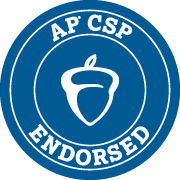AP Computer Science Principles: Cybersecurity
- Level High School
- Contact Hours 135
- Timeframe Year
This course introduces students to the foundational concepts of computer science and challenges them to explore how computing and technology can impact the world. In this Cybersecurity version of the course, students will explore all the AP CSP requirements with an emphasis on Cybersecurity applications in JavaScript. This material is based upon work supported by the National Cybersecurity Training & Education (NCyTE) Center and the National Science Foundation under Grant No. 1548315. Visit www.NCyTE.net for more information on the NCyTE Center and other cybersecurity curriculum.
To view the entire syllabus, click here or click to explore the full course.
|
Introduction to Programming
Karel is a dog that only knows how to move, turn left, and place tennis balls in his world. You can give Karel these commands to instruct him to do certain things. We use Karel to show you what it means to program, and allow you to focus on problem-solving. |
|
Practice PT: Pair-Programming Paint!
Karel is a dog that only knows how to move, turn left, and place tennis balls in his world. You can give Karel these commands to instruct him to do certain things. We use Karel to show you what it means to program, and allow you to focus on problem-solving. |
|
Programming with JavaScript
Students learn the basics of JavaScript, including variables, user input, control structures, functions with parameters and return values, and basic graphics, how to send messages to objects. |
|
JavaScript Control Structures
Students learn how to use booleans and logical operators with control structures to make more advanced programs in JavaScript. |
|
Functions and Parameters
Students learn how to write reusable code with functions and parameters. |
|
Practice PT: Tell a Story
Students apply what they've learned from the previous module to write reusable code with functions and parameters. |
|
Basic Data Structures
Students learn about lists and arrays which are essential basic data structures that any program will use. |
|
Digital Information
Students learn about the various ways to represent information digitally including number systems, encoding data, programmatically creating pixel images, comparing data encodings, compressing and encrypting data. |
|
Practice PT: Steganography - Color Channels
In this project, students will be implementing a form of cryptography known as Steganography. |
|
Encryption
In this unit, students will learn about the various ways we encrypt information. Topics covered include encoding and decrypting Caesar and Vigenere ciphers, and understanding symmetric and public key encryption |
|
Practice PT: Create an Image Filter!
In this project, students pair up with a partner to develop a novel image filter that can be applied to any digital image of their choosing. |
|
The Internet
Students explore the structure and design of the internet, and how this design affects the reliability of network communication, the security of data, and personal privacy. |
|
Cybersecurity
In this unit, students will learn about assessing different cybersecurity risks on both a personal level and a wider network level. |
|
Project: Cyber Ethics
In this project, students will choose one of four articles on cyberethics and write a position paper. Based on that article, they will provide an arguable opinion about who is responsible and why. |
|
Data
Students explore using computational tools to store massive amounts of data, manipulate and visualize data, find patterns in data, and pull conclusions from data. |
|
Project: Present a Data-Driven Insight
Students explore using computational tools to store massive amounts of data, manipulate and visualize data, find patterns in data, and pull conclusions from data. |
|
Project: The Impacts of Computing
While the performance task is no longer a graded part of the AP test, the skills needed for the performance task are still a part of the curriculum. This module will give students a chance to apply these concepts in a project format. |
|
Create Performance Task
|
|
AP Exam Review
Students review of the topics covered in the course and practice solving AP Exam style multiple choice questions. |
|
Creative Development
This unit introduces students to the theory and practice of user interface design. Students learn about what makes an engaging and accessible user interface, and will employ an iterative design process including rapid prototyping and user testing to design and develop their own engaging web pages. |
|
Final
Final exam for the course. |
Explore programs that your students will build throughout this course!

CodeHS is recognized by the College Board as an endorsed provider of curriculum and professional development for AP® Computer Science Principles (AP CSP). Using an Endorsed Provider affords schools access to resources including an AP CSP syllabus pre-approved by the College Board’s AP Course Audit, and officially recognized professional development that prepares teachers to teach AP CSP. This endorsement affirms only that components of CodeHS’s offerings are aligned to all the AP Curriculum Framework standards and the AP CSP assessment.
Here are a few examples of teacher resources and materials to use in the AP Computer Science Principles: Cybersecurity course
AP Computer Science Principles: Cybersecurity is aligned with the following standards
| Standards Framework | View Alignment |
|---|---|
| Nebraska Foundations of Computing | View (100%) |
| AP Computer Science Principles 2020 | View (100%) |
| North Carolina Computer Science I | View (94.1%) |

Create and organize Assignments in any CodeHS course that you're teaching. You can even add custom assignments to pre-existing CodeHS courses.
Learn MoreDidn't find what you were looking for? Here are a few links that might be useful to you.

Visit www.NCyTE.net for more information on the NCyTE Center and other cybersecurity curriculum.